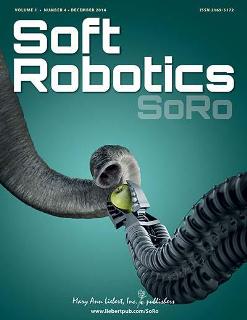Jan 9 2015
By defining a set of key metrics to evaluate the fuel systems available to drive autonomous and wearable soft robots, a team of engineers and chemists are able to compare the advantages and limitations of current technology options.
 Soft Robotics, a peer-reviewed journal published quarterly online with Open Access options and in print, combines advances in biomedical engineering, biomechanics, mathematical modeling, biopolymer chemistry, computer science, and tissue engineering to present new approaches to the creation of robotic technology and devices that can undergo dramatic changes in shape and size in order to adapt to various environments. Credit: ©Mary Ann Liebert, Inc., publishers
Soft Robotics, a peer-reviewed journal published quarterly online with Open Access options and in print, combines advances in biomedical engineering, biomechanics, mathematical modeling, biopolymer chemistry, computer science, and tissue engineering to present new approaches to the creation of robotic technology and devices that can undergo dramatic changes in shape and size in order to adapt to various environments. Credit: ©Mary Ann Liebert, Inc., publishers
They assess various types of pneumatic energy sources and their benefits for specific applications in an article published in Soft Robotics, a peer-reviewed journal from Mary Ann Liebert, Inc., publishers. The article is available on the Soft Robotics website.
Michael Wehner and coauthors from Harvard University (Cambridge and Boston, MA), Oregon State University (Corvallis, OR), Carnegie Mellon University (Pittsburgh, PA), Robot G and I Research (Bedford, MA), Worcester Polytechnic Institute (Worcester, MA), and Cornell University (Ithaca, NY), characterize the most advanced pneumatic energy systems designed to power untethered and wearable soft robots based on their energy density and flow capacity, as well as noise, toxic byproducts, application-specific requirements, and the time and additional parts needed for development. The goal of the study, entitled "Pneumatic Energy Sources for Autonomous and Wearable Soft Robotics," is to provide a framework for configuring fuel systems in soft robotics.
"As soft pneumatic systems start to gain acceptance in robotic applications, it is vital that the advantages and limitations of different energy systems are fully explored. This paper provides comparisons and analysis that will useful for anyone designing such systems," says Editor-in-Chief Barry A. Trimmer, PhD, who directs the Neuromechanics and Biomimetic Devices Laboratory at Tufts University (Medford, MA).